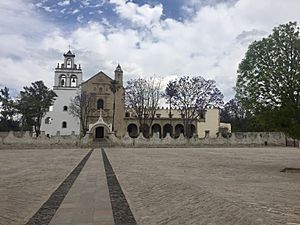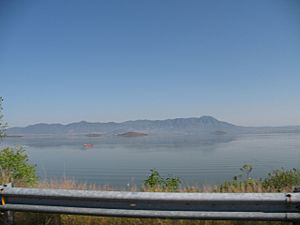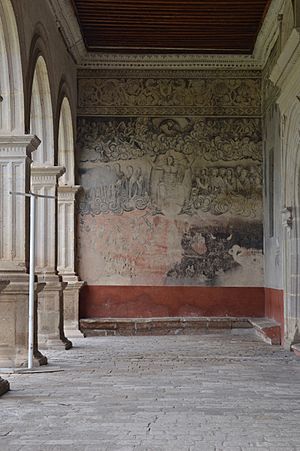Cuitzeo facts for kids
Quick facts for kids
Cuitzeo
|
|
|---|---|
|
Municipality
|
|

Church and former monastery of Santa María Magdalena
|
|
| Country | |
| State | Michoacán |
| Municipal Seat | Cuitzeo del Porvenir |
| Town Founded | 1550 |
| Municipality Founded | 1825 |
| Population
(2010)Municipality
|
|
| • Municipality | 28,227 |
| • Seat | 8,760 |
| Time zone | UTC-6 (Central (US Central)) |
| • Summer (DST) | UTC-5 (Central) |
| Website | Official site: http://www.cuitzeo.gob.mx |
Cuitzeo (pronounced kwee-TSEH-oh) is a town and a larger area (called a municipality) in the northern part of Michoacán, a state in Mexico. The main town, where the local government is, is called Cuitzeo del Porvenir.
It's found in a flat area near Lake Cuitzeo, a big but very shallow lake that is sadly at risk of drying up. The town officially started in 1550 when a large Augustinian monastery was built. This monastery still stands today. Cuitzeo del Porvenir is the center of a rural municipality, providing local government for the communities around it.
Contents
Exploring the Town of Cuitzeo del Porvenir
The town of Cuitzeo is located about 30 kilometers (18 miles) north of Morelia. It sits right on the northern shore of Lake Cuitzeo. It's a peaceful, rural town with narrow streets. Most buildings have white walls and roofs made of thatch or tiles.
People and animals like donkeys often travel the streets. The main sounds you hear are usually birds singing in the trees, especially in the town's main square. The town's main activities are farming, raising animals, trading goods, and fishing. In 2010, about 8,760 people lived here.
The Historic Santa María Magdalena Monastery
The most important building in Cuitzeo is the old Santa María Magdalena monastery. It's next to the main square. This large complex includes a church, a cloister (a covered walkway), a garden, and an open chapel.
Its main feature is its beautiful front, called a facade, which is in a style called Plateresque. It has detailed carvings of Spanish royal symbols, Christian signs, Augustinian badges, and images from local indigenous cultures. This shows that it was one of the most impressive monasteries of its time.
The design of the church front was influenced by a church in Acolman, but Cuitzeo's is bigger and more grand. A Purépecha craftsman named Juan Metl is believed to have designed and carved the facade. His signature is carved on a decorative plaque near the main entrance. This is the only known example of an artist's signature from early colonial Mexico.
Another special part of the outside is the open chapel. It has a fancy frame and is located behind the monastery's entrance area. Inside, you can see a well-preserved painting from the 1500s called the Last Judgment. There's also a painting from the 1600s of a crucified friar, who might be Antonio de Roa.
The Augustinian order started building the monastery in 1550. They built it on the ruins of an old Purépecha temple dedicated to the sun god Curicaueri. They even used stones from the old temple. The building served as a main center for the Augustinian order and a school.
In 1865, it was used as a military fort. Later, in 1965, the Instituto Nacional de Antropología e Historia (National Institute of Anthropology and History) took care of the building. In 1974, a graphic arts museum (Museo de la Estampa) opened there. This museum has a permanent collection of works from over forty artists. You can also find areas dedicated to Purépecha archaeology and religious items from the colonial period. The upper floor of the cloister has a library with over 1,100 old books, mostly from the 1700s and 1800s.
Other Important Buildings
Other important buildings in Cuitzeo include an old Franciscan hospital from the 1700s. There are also several churches: the Santa Magdalena Church, the Concepción Church, the San Pablo Church, the Calvario Church, and the Virgin of Guadalupe Sanctuary. These churches have sculptures and paintings that date back to the 1500s.
In 2006, the town of Cuitzeo was given the special title of "Pueblo Mágico" (Magical Town). This title is given to towns in Mexico that have special natural beauty, cultural richness, or historical importance.
The Cuitzeo Municipality
The town of Cuitzeo del Porvenir is the main town for many other communities in the Cuitzeo municipality. The municipality covers an area of about 257.87 square kilometers (about 99.5 square miles). It shares borders with other municipalities in Michoacán and with the state of Guanajuato. The local government is led by a municipal president and other local officials.
Besides the main town, some other important communities in the municipality include Cuaracurio (with 1,656 people), San Agustín del Pulque (2,924 people), Mariano Escobedo (2,859 people), Cuamio (2,353 people), Dr. Miguel Silva (1,021 people), and Jeruco (960 people). These numbers are from 2010.
Historical Sites and Churches
Important historical sites include the Tres Cerritos archaeological area. Here, ancient burial chambers for adults and children have been found. This was a ceremonial center that dates back to around 600 CE. Another site is Manuna Hill, located on the northwest shore of the lake.
Many communities in the municipality have important churches. These include the Chapel of the Child Jesus in Cuamio, the San Juan Bautista Church in Jeruco, and the San Agustín Church in San Agustín del Pulque.
Geography and Nature
Cuitzeo is located in a flat area of northern Michoacán called the Cuitzeo Depression. There are only small hills nearby, like Manuna and Melón.
Water and Wildlife
The area's water comes mainly from Lake Cuitzeo. There are also some streams that flow only during certain seasons and warm springs, like San Agustín del Maíz. Lake Cuitzeo is a large but very shallow lake. It gets its water from fresh springs.
The lake is home to over ninety types of water and semi-water plants. It also has fish like silversides, catfish, and carp. In the winter, many swallows and ducks come here to spend the colder months. They migrate all the way from Canada and the United States. Sadly, the lake is in danger of drying up.
Areas around the lake that are not water are mostly grasslands. You can find plants like opuntia (prickly pear cactus) and huisache (Acacia trees), which grow in dry places. Wildlife in the area includes coyotes, raccoons, armadillos, and various fish. There are also some groups of pine trees.
Climate
Cuitzeo has a mild climate. It gets most of its rain during the summer. The average yearly rainfall is about 906.2 millimeters (35.7 inches). Temperatures usually range between 10.2 and 27.5 degrees Celsius (50.4 and 81.5 degrees Fahrenheit).
A Look at Cuitzeo's Past
The name Cuitzeo comes from the Purépecha language. "Cuiseo" means "place of water containers." The way we spell it today dates back to the 1500s. Before the Spanish arrived, the area was influenced by several ancient cultures. These included the Chupícuaro, Teotihuacán, and Tula cultures. By the end of this period, the area was controlled by the powerful Purépecha Empire.
When the Spanish colonial period began in 1528, the area was given to a Spanish leader named Gonzalo López. However, by 1547, it had become a "Republic of Indians," meaning it had some self-rule. Christian missionaries, especially the Augustinians, began working here. Francisco de Villafuerte and Miguel de Alvarado started building the Santa María Magdalena monastery in 1550. This is considered the official founding of the modern town.
The 1800s brought many political changes. In 1825, Cuitzeo was part of the "Departamento Norte." In 1831, it officially became a municipality. In 1861, it was named the official seat of the current municipality, with the name Cuitzeo del Porvenir. During the Reform War, liberal forces took control of the town on April 7, 1865. In 1870, Santa Ana Maya separated from Cuitzeo to form its own municipality.
The 1900s started with the town being attacked during the Mexican Revolution by a group of bandits. In 1919, Huandacareo separated to form a new municipality, and in 1950, Copándaro did the same. Important improvements came to Cuitzeo in the mid-1900s. Running water was installed in 1955, and electricity arrived in 1964. In 1975, all the building fronts in the town were renovated, giving them a fresh look.
Life and Culture in Cuitzeo
The main ways people make a living in Cuitzeo are through farming, raising animals, trading, and fishing. A very common craft here is making baskets and other items from different types of plant fibers. These include floor mats and hats, made using reeds and other plants found near the lake. You can usually find these handmade items for sale in the center of Cuitzeo town.
Major festivals in Cuitzeo include celebrations for the Virgin of the Conception in February and for the town's patron saint, Mary Magdalene, in July. There is also a non-religious event in October that celebrates the arrival of Spanish culture. Other celebrations include the Fiesta del Buen Temporal in September and an annual festival at the Cerrito Temple in November.
Traditional foods include corundas (a type of tamale), tamales, uchepos (another type of tamale), and esquites (corn kernels). You can also find charales (small fish from the lake) prepared in different ways. The most traditional drinks are pulque (a fermented drink) and atole (a warm, thick drink).
See also
 In Spanish: Cuitzeo del Porvenir para niños
In Spanish: Cuitzeo del Porvenir para niños




